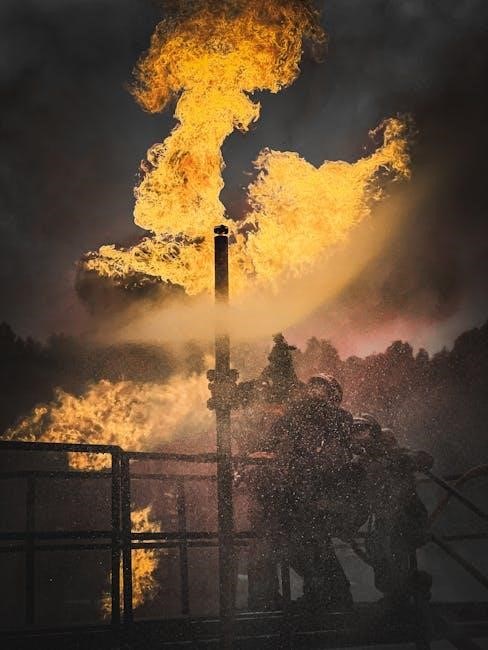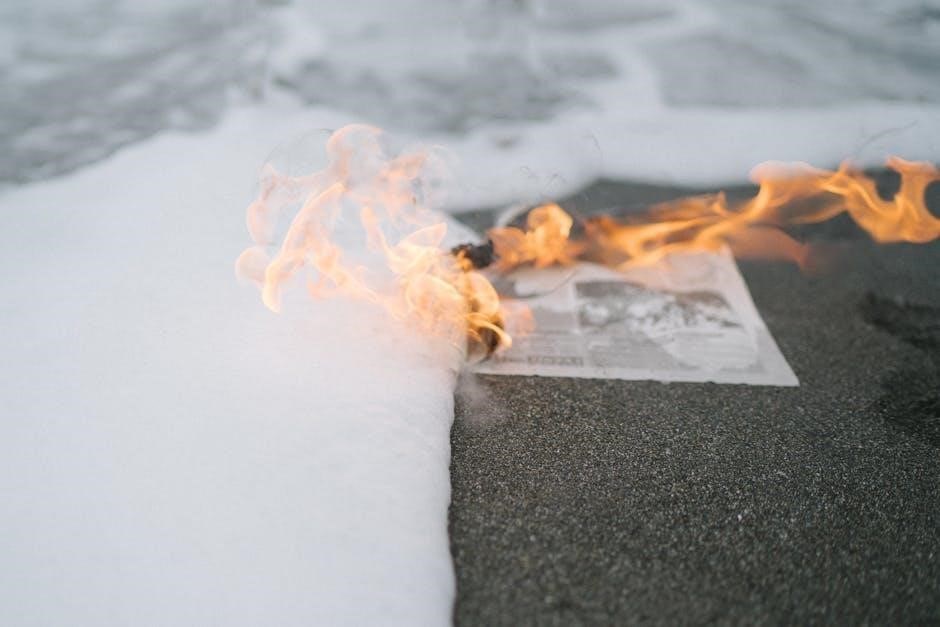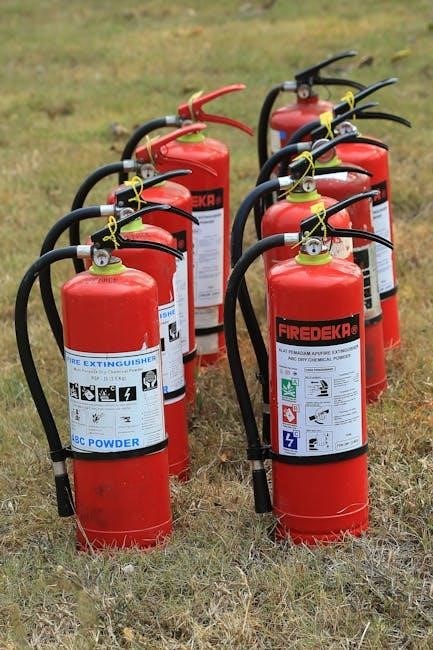Fire extinguishers are essential tools for controlling and extinguishing fires in various environments. They are classified into different types based on the materials they contain and the fires they combat. Understanding their proper use and classification is crucial for effective fire safety and prevention strategies.

1.1 Importance of Fire Safety
Fire safety is critical for protecting lives, property, and the environment. Fires can cause devastating damage, injuries, and loss of life, making prevention and preparedness essential. Fire extinguishers play a vital role in controlling and extinguishing fires before they escalate. Understanding their proper use and classification ensures effective response, minimizing risks and damage. Regular education and awareness are key to fostering a safe environment, enabling individuals to act swiftly and confidently in emergencies.

1.2 Overview of Fire Extinguisher Types
Fire extinguishers are categorized into five primary types: water, foam, dry powder, carbon dioxide (CO2), and wet chemical. Each type is designed for specific fire scenarios, determined by the combustible materials involved. Water extinguishers are effective for ordinary combustibles, while foam and dry powder are suited for flammable liquids and multiple fire classes. CO2 extinguishers are ideal for electrical fires, and wet chemicals are used for cooking oils. Understanding these distinctions is key to effective fire management and safety.

Types of Fire Extinguishers
Fire extinguishers are categorized into five primary types: water, foam, dry powder, carbon dioxide (CO2), and wet chemical. Each is designed for specific fire scenarios.
2.1 Water Extinguishers (Class A)
Water extinguishers are designed to combat Class A fires, involving ordinary combustibles like wood, paper, and cloth. They work by cooling the fuel source, reducing the temperature below the ignition point. These extinguishers are commonly used in offices, homes, and areas with similar fire risks. However, they are ineffective against electrical or grease fires, making them unsuitable for kitchens or areas with flammable liquids. Proper training is essential for their safe and effective use;
2.2 Foam Extinguishers (Class A and B)
Foam extinguishers are versatile, tackling Class A and B fires, such as combustible solids and flammable liquids. They create a barrier, smothering the fire by depriving it of oxygen. Ideal for industrial and garage settings, foam extinguishers are effective on petroleum-based fires. They are not suitable for electrical fires. Their ability to cool and blanket the fuel makes them a reliable choice for various fire risks, ensuring safe and efficient fire control in diverse environments.
2.3 Dry Powder Extinguishers (Class A, B, C, and Electrical)
Dry powder extinguishers are multi-purpose, effective against Class A, B, C, and electrical fires. They work by releasing a fine powder that smothers flames and disrupts combustion. Suitable for homes and businesses, they are ideal for mixed-risk areas. These extinguishers are available in stored-pressure or cartridge-operated designs. While they leave a residue, their broad application makes them a popular choice. Regular maintenance is crucial to ensure reliability in emergency situations.
2.4 Carbon Dioxide (CO2) Extinguishers
Carbon dioxide extinguishers are highly effective for Class B flammable liquids and Class C electrical fires. They work by displacing oxygen, smothering the fire without leaving residue. Ideal for sensitive areas like data centers or laboratories, CO2 extinguishers are non-corrosive and protect electrical equipment. However, they are not suitable for Class A fires as they do not cool the fuel. Regular inspection is essential to ensure functionality. Always use in well-ventilated spaces to avoid asphyxiation risks.
2.5 Wet Chemical Extinguishers
Wet chemical extinguishers are primarily designed for Class K fires involving cooking oils and fats. They work by forming a saponification reaction, creating a foam barrier that cools and suffocates the fire. These extinguishers are also effective on Class A fires. They are ideal for commercial kitchens and food processing areas due to their ability to prevent fire re-ignition. Regular maintenance is crucial to ensure the chemical’s effectiveness and avoid corrosion. Always follow manufacturer guidelines for inspection and recharge.
Fire Classes and Their Corresponding Extinguishers
Fires are categorized into classes based on fuel sources. Class A involves ordinary combustibles like wood. Class B includes flammable liquids like gasoline. Class C pertains to electrical fires. Class D involves combustible metals, and Class K covers cooking oils. Each class requires specific extinguishers to ensure safe and effective fire control.
3.1 Class A Fires (Ordinary Combustibles)
Class A fires involve ordinary combustibles such as wood, paper, cloth, rubber, and plastics. These materials produce glowing embers and leave ash when burned. Water-based extinguishers are most effective for Class A fires, as they cool the fuel source, reducing temperatures below the ignition point. NFPA standards recommend using water or wet chemical extinguishers for these types of fires, ensuring safe and efficient control in residential and commercial settings.
3.2 Class B Fires (Flammable Liquids)
Class B fires involve flammable liquids such as gasoline, oil, paint, or propane. These fires spread quickly and require extinguishers that smother the fuel or disrupt combustion. Foam, dry powder, or carbon dioxide extinguishers are effective for Class B fires. Foam creates a barrier, while CO2 displaces oxygen, starving the fire. Dry powder smothers the flames by blocking oxygen and preventing chemical reactions. Using water is unsafe, as it can spread the liquid and worsen the fire. Proper selection is critical for safe and effective control.
3.3 Class C Fires (Electrical Equipment)
Class C fires involve electrical equipment, such as appliances, wiring, or machinery. These fires pose unique risks due to the potential for electric shock. Water-based extinguishers are unsafe, as they conduct electricity. Instead, carbon dioxide (CO2) or dry powder extinguishers are recommended, as they smother the fire without conducting electricity. CO2 displaces oxygen, while dry powder interrupts the chemical reaction. Always disconnect power if possible and prioritize evacuation before attempting to extinguish such fires. Professional handling is often advised for safety.
3.4 Class D Fires (Combustible Metals)
Class D fires involve combustible metals like magnesium, titanium, or aluminum. These fires burn at high temperatures and react violently with water. Specialized extinguishing agents, such as dry sand or powdered fire extinguishers, are required. These agents smother the fire by starving it of oxygen and cooling the metal. Water and foam extinguishers are ineffective and dangerous, as they can cause the metal to explode or intensify the fire. Handling Class D fires demands specific training and equipment to ensure safety and effectiveness.
3;5 Class K Fires (Cooking Oils and Fats)
Class K fires involve cooking oils and fats, often occurring in commercial kitchens. These fires burn at high temperatures and can reignite if not properly extinguished. Wet chemical fire extinguishers are specifically designed for Class K fires, as they smother the fire and cool the surface, preventing reignition. Water should never be used, as it can cause the oil to splash and spread the fire. Proper training is essential for safely managing these hazardous kitchen fires.
Fire Extinguisher Color Codes and Identification
Fire extinguishers are color-coded for quick identification. Red indicates water, cream for foam, blue for dry powder, black for CO2, and yellow for wet chemical. Labels and markings are standardized to ensure clarity and compliance with safety regulations.
4.1 Color Coding Guide
Fire extinguishers are color-coded to ensure rapid identification in emergencies. Red indicates water extinguishers, cream for foam, blue for dry powder, black for CO2, and yellow for wet chemical. Each color represents the extinguishing agent inside, helping users quickly select the right tool for the fire type. This standardized system improves safety and compliance with fire safety regulations. Clear labels and markings further enhance visibility and understanding, ensuring proper use in critical situations.
4.2 Labels and Markings
Fire extinguisher labels provide critical information, including the fire classes they are designed to combat, operating instructions, and maintenance requirements. These labels are standardized to ensure clarity and compliance with safety regulations. They often feature pictograms to visually indicate the extinguisher’s use, making them accessible to everyone. Additionally, labels include manufacturer details and certification marks, ensuring the extinguisher meets local and international fire safety standards. Clear markings enhance visibility and help users make quick, informed decisions during emergencies.

Maintenance and Inspection of Fire Extinguishers
Regular inspection and maintenance of fire extinguishers are crucial to ensure they function properly in emergencies. This includes checking pressure, inspecting hoses, and verifying accessibility and visibility.
5.1 Regular Inspection Requirements
Regular inspections of fire extinguishers ensure they are operational and ready for emergencies. Inspect pressure gauges, hoses, and nozzles for damage or blockages. Verify that extinguishers are easily accessible, visible, and not obstructed. Check labels for legibility and compliance with safety standards. Record inspection dates and results. Perform monthly visual checks and annual professional inspections as per NFPA 10 guidelines to maintain reliability and safety. Address any issues promptly to ensure extinguishers function correctly when needed.
5.2 Recharging and Refilling Procedures
Recharging and refilling fire extinguishers are critical for maintaining their effectiveness. After use, extinguishers must be recharged promptly by trained professionals to ensure safety and reliability. Inspect the unit for damage before refilling, and use approved agents and equipment. For dry powder and CO2 extinguishers, recharge only when pressure drops below safe levels. Wet chemical extinguishers may require replacement of the chemical agent. Always follow manufacturer guidelines and safety protocols to ensure proper functionality after refilling or recharging.
How to Use Fire Extinguishers Effectively
Using fire extinguishers effectively requires knowledge of the PASS method: Pull the pin, Aim the nozzle, Squeeze the handle, and Sweep the discharge across the fire base.
6.1 The PASS Method
The PASS method is a widely recognized technique for using fire extinguishers effectively. It stands for Pull, Aim, Squeeze, and Sweep. First, Pull the safety pin or ring to release the lock. Next, Aim the nozzle or hose at the base of the fire, not the flames. Then, Squeeze the handle to discharge the extinguishing agent. Finally, Sweep the nozzle from side to side, covering the entire area of the fire with the agent. This method ensures proper technique and maximizes the chances of extinguishing the fire safely.
6.2 Safety Precautions During Use
When using a fire extinguisher, always prioritize your safety. Ensure you have a clear escape route and avoid fighting a fire that is too large or spreading rapidly. Wear protective gear if available, and never use the wrong type of extinguisher for the fire class. Keep a safe distance from the fire to avoid heat exposure. If the extinguisher is empty or malfunctioning, evacuate the area immediately. Always follow the PASS method and be aware of your surroundings to prevent accidents or injuries.

Regulations and Standards for Fire Extinguishers
Fire extinguishers must comply with regulations like NFPA 10, ensuring proper installation, maintenance, and testing. Adherence to local and international standards is mandatory for safety.

7.1 NFPA 10 Standard for Portable Fire Extinguishers
NFPA 10 provides comprehensive guidelines for portable fire extinguishers, including selection, installation, inspection, and maintenance. It ensures extinguishers are appropriate for specific fire hazards, outlining requirements for labeling, accessibility, and training. Compliance with NFPA 10 is critical to ensure effective fire safety and proper functioning of extinguishers in emergency situations. Regular inspections and adherence to these standards help maintain reliability and performance, safeguarding people and property from fire risks.
7.2 Local and International Compliance Requirements
Fire extinguishers must comply with both local and international standards to ensure safety and effectiveness. Regulations vary by region but often align with global standards like EN 3-7 in Europe or AS 2444 in Australia. Local authorities may require specific certifications or installations. Compliance ensures extinguishers meet safety, performance, and environmental criteria. Proper labeling, inspections, and maintenance are critical for adherence to these standards, ensuring reliability in emergency situations worldwide.




